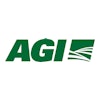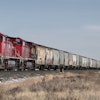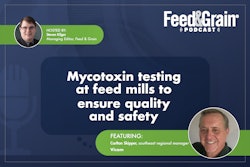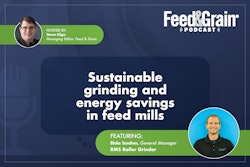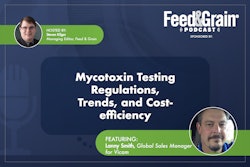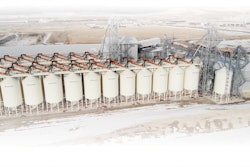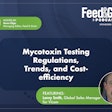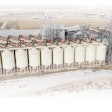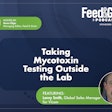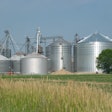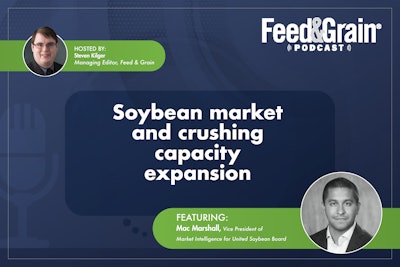
In this episode,Steven Kilger, managing editor ofFeed & Grainand the host of theFeed & Grain Podcast副总裁,以及Mac马歇尔rket intelligence for theUnited Soybean Board(USB) and theUS Soybean Export Council, discuss a variety of soybean-related topics, from the state of the U.S. soybean market to this year's harvest to the incredible wave of expansion in crush capacity that's occurring in the U.S. today.
Steven Kilger:Hey everyone, my name is Steven Kilger. I'm the managing editor ofFeed & Grainmagazine and the host of theFeed & Grain Podcast. Thank you so much for joining me today as we dive deep into the issues affecting feed manufacturing, grain handling and allied industries.
Today I'm speaking with Mac Marshall, vice president of market intelligence for the United Soybean Board (USB) on the US Soybean Export Council.
We're talking about today's soybean markets, this year's soybean harvest, and the rise of the soybean crush capacity across the U.S. Before we start, if you're listening to this on a podcasting app, please rate us and subscribe. If you're listening online, sign up for the Feed & Grain newsletter Industry Watch to see the latest podcast. And of course, stay up to date with all the latest news from around the industry. Now on to the show.
Mac Marshall:Good morning, Steven. And thanks for having me on the program.
Kilger:To start, why don't you just tell me and the listeners a little bit more about you and what you do?
Marshall:Delighted to be here. My name is Mac Marshall. I'm the vice president of market intelligence for the United Soybean Board. In this role, I serve on a strategy team, and work with a couple of other staff members to help provide our board of directors. We have a board of 77 farmer directors who are tasked each year with the pretty monumental responsibility of deciding where their investments are going to go for the next funding cycle to help set up and improve the viability and strength of the domestic soybean industry, from farmer's standpoint in the years to come. That's one piece of it. Certainly being able to talk through markets, developments, trends, you know, see where the proverbial ball is going ahead of when the ball gets there.
That's all, in the agreement, of what we do. Of course, the other piece is exactly what we're doing here. A lot of media external speaking. I'm actually at a conference in Miami right now for aquaculture. I just gave some remarks about soy's role there, as well as bracket developments. So it's fun. I have been in this role for about three and a half years as USB wanted to bring all those capabilities back in 2020.
I started very early on in the pandemic. It's a lot more fun now than it was then, because we're getting to get out and see people and getting out on farms, going to production facilities. But before that, I had worked, well first coming out of college in the US Bureau of Labor Statistics, as an analyst, they got placed on a food and agriculture team, which was the start of my voyage of discovery into the world of the U.S. and global food and ag.
我不来自一个农业背景。其他e's no farming in my family. I come from the East Coast. So getting that bit of exposure initially, when I started working at my first job out of college was instrumental for showing me how interesting the world of food and ag is, and that this was the place I wanted to spend my career eventually.
I was in a role for about five years, then my career took me out of the subject matter of agriculture, more working on financial services, professional services, real estate, also within BLS, but something was missing for me. And that was getting back to ag subject matters, just something about it spoke to me. And at that point, now we're looking at about 10 years ago, started talking with Monsanto as then agricultural leader, major company, you know, those looking to expand again, its analytical capabilities, particularly from an economic analysis and crop market analysis standpoint, for their corporate strategy group. So I moved out to St. Louis about 10 years ago, and without knowing anything about the region.
It's been great. I've been out there for about 10 years. I first had that role in corporate strategy at Monsanto, and then spanning both sides of the Monsanto and Bayer merger. Worked in a little bit more of a global market access type role with our international government affairs team, and some sort of embedding economic analysis into the way that we would hope and work with governments to help enable and facilitate trade of agricultural products in which our company's products were the inputs.
That brings us to here early on in the pandemic, I got approached about this role at USB, which seemed incredibly exciting drawing on a lot of prior experience and skills that I think honed and developed on time, particularly at Monsanto. And the time was right to come on ovation, which I had not done before. And it's it's been a lot of fun and enjoyed that time working here over the last three and a half years.
Kilger:That's great! Well, number one because like you, I didn't have an agriculture background, and it's one of those things where I feel like the sector doesn't promote itself well enough. People are always trying to hire people with farm backgrounds, but I'm like it's a amazing industry. If you gave it a chance to outside people.
Marshall:其他e are a couple of things around that, that keep coming back to me as a common theme. A couple of weeks ago, I was honored at the Harvest, which is an annual gathering put on by U.S. farmers and ranchers. It brings together, what do they call it "where the suits meet the boots," right? So you're bringing together really proactive farmers and ranchers from different communities across the country, really through the value chain going even into the financial side of the equation.
Bringing together all these disparate groups, you've got this intersection of everybody's kind of touching ag, but it's an intersection of people who have kind of grown up in the ag world, people's habits. There's one resounding theme, I mean, there are several resounding themes, but one is on this topic that I think was coming out. At the tailend, there was the need to have more and more points of view and perspectives, backgrounds that come from non-traditional spaces, people who haven't grown up on a farm or grown up in agriculture but have an interest in it.
I think being able to showcase that it's a very exciting and dynamic field to be in. I can frame it as a challenge. I don't necessarily think it is challenging, because the story of agriculture is so exciting. It's one that's always been of innovation, you really think about it, you know, bringing more and more voices into it, I think is going to be critical.
When I look at my career, I've been very, very fortunate to have had the career that I've had and to have had the experience of working for the organizations that I have. But if I'm breaking it down, it happened somewhat serendipitously, if I hadn't had that initial exposure to, you know, learning a bit of the world of agricultural statistics, and how to look at markets and just getting thrown into that as a subject matter that I was going to be covering daily. I don't know if I would be here.
When we think about the future of agriculture, the existential needs of humanity, of course, feeding humanity, but also being able to find more renewable sources of energy. It's got a strong role in that through biofuels. That was one example, as we think about the challenges of the 21st century, sustainable development goals. All of this goes back to agriculture and farming as the starting point that really kind of kicks off the flywheel for success.
I think another thing to remember, is it's one way or another, whether we realize it or not, whether you live in a city, or whether you're out in the countryside, independent of where you are in the world -- agriculture does bind us all. We all need food, shelter and clothing. I think as we recognize increasingly that it is truly a unifying tie through all of us, hopefully, that'll inspire more people to get involved who are coming both in the traditional ag and farming backgrounds, as well as people who maybe haven't given it thought before. It's an exciting challenge. Even I'm excited to hear that you've come from one of those traditional backgrounds as well but had gotten the Ag bug once you get kind of passionate about it that you can't shut it off.
Kilger:[Feed & Grain] used to be owned by theAmerican Farm Bureau Federation, and it allowed me to get to meet people on the farm -- farmers and growers, ranchers, all these people and you start to realize, it's just a great, great industry. I think we might have someone in common and our past, Mace Thornton, I don't know if you know him.
Marshall:Yeah, yeah, Mace. That's another good point here. This world of ag does kind of keep recirculating. Once you're in it, you find the other, maybe you're not with the same organization, but you still find other ways to help advance the industry and the understanding of it, because it's the lifeblood of all of us.
2023 soybean harvest update
Kilger:It is, and it's one of the friendliest, nicest industries, you'll find to be very, very generous and very kind. Now, can you give us a little bit of an update on this year's soybean harvest in the United States? It's wet here in Wisconsin, these last couple of days. Hopefully it's dryer elsewhere.
Marshall:从很早开始,当它是明确的,我们的计划ning at three and a half million acres of soybeans were down about 4 million acres from last year. As well as just an overall tight inventory position that we're looking at this was going to be riding the weather market all summer weather always is an influencer of price. And so then when the condition reports come out, that's what a lot of people are looking at. So not to be champion of the obvious there. But when you have a tight supply there, you see I think a lot more swings in price that are responding to weather, it just becomes much more of a weather market. So that's a lot of what we've been in throughout the summer. We've we've seen some ups and downs. And now where we are, as we start to approach October, timelines are rolling throughout the country while you're seeing harvest start in many parts of it.
We're talking to a couple of farmers this week. Who started cutting recently? And overall, the crop size we're looking at is more than 4 billion bushels 4.1. And change, I think is the latest USDA estimate. And down from where it's been over the last couple of years. Again, I mentioned that area reduction in that area that season. I mean, that's a key factor here, we had a lot more corn down to the ground, which I think was initially expected.
My read on that is, well, let's look back to 2022, when there were a lot of signals to plant a lot of corn. But due to high fertilizer prices, as well as availability issues in some parts of the country, not as much corn got planted as farmers wanted to plant in 2022. I think we're seeing a bit of a lagged effect for that this year.
Now, when it comes to price and how the harvest is shaping up, I think right now, conditions are 50% good-to-excellent, which is the most pressure from a rating standpoint that the U.S. soybean crop has seen in about 10 years. There's continued sustainable intensification of production as well as farmers' overall resilience managing through drought in many parts of the country for extended stretches the summer. The heatwaves this summer! I live outside of St. Louis, that's the epicenter of a lot of agricultural production. I mean, we had a couple of weeks there where the heat index was over 115. These were coming in approaching some of the critical points of crop development. Overall, we're looking at this crop probably going to be the sixth or seventh largest of all time when it's all said and done. That's exciting. We've got to replenish that tight inventory position.
We've already started the new marketing year for whole soybeans, and exports are up relative to last year. Farmers delivering over the coming weeks are critical to bring that off and help get it into the hands of buyers, both domestically and around the world. It's shaping up pretty well.
Other things that are impacting the overall marketplace right now -- Brazilian planting of their 2024 crops is already proceeding ahead of pace. That's, of course, on the heels of a very, very large crop for the 20 to 23 marketing year. Argentina is looking to rebound from an absolute crop failure this past marketing year where production was probably about 40% of what was expected.
巴西大作物,他们抵消losses to Argentina, a couple of expectations of continued growth in production. Both of those countries for this next year are more of a rebound. Some of those things are kind of weighing on prices at the moment, but certainly, $13 beans, strong pricing environments relative certainly relative to a couple of years ago wondering the trade war. But let's not forget that that's the revenue side of the equation for farmers.
其他e's also a cost side. While we've seen mitigation, fertilizer prices, the overall interest rate environment has I think presented a lot of challenges to farmers who have to take on a whole lot of operating loans for financing operations, purchasing capital equipment lands. Just rates are, I think, felt even more acutely in the farming community than other parts of the economy. There's never a year without challenges, but fortunately, we've got an incredibly resilient half million soybean farmers out there in the United States.
Kilger:It's not talked enough about how these rising interest rates for agriculture as a whole, since it's it's an industry that does a lot of short-term loans with banks. Same with grain elevators and all these other things. It's these it's interest, it's gonna affecting their bottom line in this moment.
Marshall:I think about any type of refinance of a house right now, they only do that when when rates are really low. But you know, when you've got to take out those loans each year regularly, like you said, you know, short term, in some cases, that's just to set yourself up for producing a crop, which will get paid on for several months down the line. That inner temporal nature of it that timing of farmers having all this outlay, and then the actual payment for the crop is deferred. I mean, that bearing a lot of risk, and I think is probably another underappreciated part of the farm economy.
Robust demand creates booming crush construction
Kilger:One, that's not talked about enough. I think agriculture gets ignored in those discussions of what interest rates are doing to people. The market seems a little strange for soybean producers right now, but hopefully, we'll get better in the future, right? It seems like everyone and their mother is building a soybean crush facility. Those markets improve within the next couple of years.
Marshall:I think that what is the environment that our farmers are selling into and we'll be selling into is one of the I think pretty robust demands here. You know, when you see the level of investment towards new crushing facilities, some of which are already coming online, a couple in Iowa, that will enable more crush. Thinking about some other parts of the country where this upwards of 30% expansion in domestic crushing capacity, certainly some parts that have been historically underserved where farmers haven't had that local point of delivery crush facility as a local source of demand.
Some of the underserved areas like North Dakota, Western Minnesota, where you've got three new plants coming in close to that area that's not historically had crushes. So farmers in dry areas now have a new point of demand. That means they're not taking as much of a basis hit. That's money back in farmers' pockets. That's critical. But the crushing expansion is a reflection of a new season for the world of soy.
What I mean by that is, reevaluation and a real appreciation of the value and versatility of soybean oil, right? This wave of crushing expansion that we have coming is different from prior iterations of when there have been expansions. Now, there's never been one of, you know, this sustained magnitude over a multi-year period.
我认为重要的是要记住,第三,the need for expanding crush has been born on the meal demand side. Now, meal demand remains very, very robust overall, and that's tied to the strength of protein demand, and the need to scale up animal protein production to help feed the growing mounds that are increasingly demanding animal protein.
其他e's a nice steady demand on the meal side of the equation, but it's the oil piece that I think is interesting right now. Historically, oils carried about a third of the value share between mainland oil for soybeans. Over the last two and a half years, it's been over 40%. A lot of that has been driven by this push for decarbonization of the economy in California, the implementation, or rather scaling up, of the California low-carbon fuel standard, which is creating more and more incentives for using based feedstocks that are renewable, such as soybean oil, as inputs for producing renewable diesel.
It's an interesting time where we've got all this crush coming online. The rationale for it is different pressures want to crush for the oil, the deals that are coming together to help finance these expansions are not ones we would have thought typical. Up until a couple of years ago, you wouldn't picture energy companies entering into joint ventures with agricultural companies, but that's what's happening.
Chevron and Bungejust as one very notable example. Chevron's looking to get the soybean oil for renewable diesel and Bunge is getting a scale-up in their crush capacity. What does all that mean? Well, that means increased meal availability, which is going to be great for animal agriculture here in the U.S. For exporters, our meal exports are up 6% relative to last year. We're on pace to set a volume record.
As we have more fresh capacity coming online over the next couple of years through 2026, I think we're going to see that trend continue, where we're both advancing opportunities for more meal utilization domestically, particularly in swine diets. There are also opportunities for expansion to many overseas markets that have a preference for U.S. soy, and are also seeing scaling up of animal agriculture, aquaculture, poultry, in many parts of the world. Aquaculture -- it's really exciting to see how that part of the value chain has been taking off.
Kilger:It is exciting, especially because, like you said, it's going to be reflected through the entire supply chain, because there'll be more meals out there. Hopefully, that will lower feed prices a bit for animal agriculture. It's something we could use. It's been a rough couple of years.
Marshall:I can't take what the futures market says as gospel, right? Because there's always things that can change again, with other disruptions that are out there. But you know, if you look at the futures curve, what the market is saying today is that over the next 18 to 24 months, we'll see a pretty substantial drop in meal prices.
It's predicated on normal production, a kind of rebalancing of supply and demand. That's certainly going to be if it comes to fruition, certainly beneficial for animal ag, right? As you said, the margins are tight. It's been it's been a rough period for a lot of producers over the last couple of years. But seeing some potential cost avoidance there by more and more meal making its way into the marketplace.
Does that have to be a welcome sight? As you know, the true gold standard is a plant-based source of protein for people and animals. As we have greater availability of that, it's a high-quality product that's penetrating the marketplace more and providing more and more benefits to an increasing number of users.
To be continued ...
Kilger:Hi everyone here just wanted to tell you that Matt and I talked for much longer than this and you can hear the rest of our conversation. You can find the rest of our conversation in our next podcast where you will talk about some of the innovations going on in soy, the Soybean Checkoff Program, and a bunch of other topics. So please tune in to that episode as well. Thank you so much for listening toFeed & Grain Podcast. We appreciate it. And we hope you stay tuned.

.jpg?auto=format%2Ccompress&crop=faces&fit=crop&h=48&q=70&w=48)

